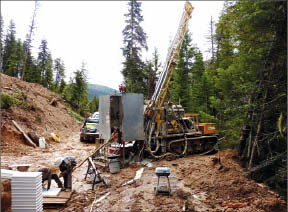When Democrat Cecil Andrus, the only governor in Idaho’s history to have served four terms, retired from the board of Coeur d’Alene Mines (CDM-T, CDM-N) after more than ten years of service, the mining company gave him a Beretta shotgun instead of a gold watch.
The gift may have raised a few eyebrows in a state like New York or California – but in Idaho, it seemed to fit right in with the
territory.
“If you’re a democrat in Idaho, you’d better go armed,” Andrus joked to a group of investment analysts and executives at a recent luncheon seminar in Toronto about mining in Idaho.
As it turns out, Andrus is an avid hunter. The mining company’s gift was a fitting thank-you.
But in a state where only 20 of the 105 seats in the State Legislature are held by Democrats, and all seven state officials elected by voters are Republicans, the joke resonated a little.
Andrus made the trip to Toronto – despite a broken leg and his upcoming eightieth birthday in August – to toot Idaho’s horn as a place for companies to look for promising mineral deposits and turn them into producing mines.
Gold was discovered in Idaho in the 1860s, and the state is rich in silver, cobalt, molybdenum and phosphate.
“Idaho is full of opportunities, and mining has been a major factor in the economy and continues to be so,” he said.
Citing the recent decision in June by the U.S. Bureau of Land Management to approve Monsanto‘s (MON-N) Blackfoot Bridge phosphate mine in southeastern Idaho, Andrus said there is opportunity in the state for mining projects of all kinds.
Idaho is also home to Hecla Mining (HL-N) and its Lucky Friday silver mine, which has been operating since 1942. Hecla is in the midst of sinking a fourth shaft at Lucky Friday, and is embarking on a scoping study to evaluate re-opening the underground Star mine in Silver Valley.
Also in Idaho are U.S. Silver (USA-T), which holds 100% of the Galena silver-copper-lead mine in the historic Silver Valley in the northern part of the state (the mine is the second-largest primary silver producer in the U.S.); and Formation Metals (FCO-T), which is building a cobalt mine and mill, and will be the only primary cobalt producer in the country. The U.S. consumes about 60% of the world’s high-purity
cobalt.
On the exploration front, Marathon Gold (MOZ-T) and Premium Exploration (PEM-V) are both making headway with their properties. Marathon Gold is developing its Golden Chest project, a past-producing mine in Idaho’s prolific Coeur d’Alene mining district, and Premium is advancing exploration work at its district-sized gold project near the old mining town of Elk City in north-central Idaho.
“Is there opportunity in Idaho? Tremendous opportunity,” Andrus told the gathering. “But you’ve got to do it right. You’ve got to sit down with all the stake-holders.”
Monsanto’s Blackfoot Bridge phosphate mine is a good example. It was approved after the company re-worked its design and said it would spend US$30 million on a liner and drainage system to prevent selenium from leaching into the groundwater. Phosphate is a major ingredient in Monsanto’s Roundup herbicide.
Andrus, who is known for his strong environmental stance, notes that he was also involved
in permitting the Thompson Creek molybdenum mine, when he served as Secretary of the Interior under U.S. President Jimmy Carter.
“There were challenges [in permitting], but we met those challenges,” he said.
The open-pit mine, which began operations in 1983, is owned by Thompson Creek Metals (TCM-T, TN-N). It is the fourth-largest primary molybdenum mine in the world.
Andrus sits on the board of Formation Metals, and is a big believer in the company’s flagship cobalt project, a primary cobalt mine under construction in Salmon, a town in central Idaho. The Big Creek hydrometallurgical complex, also 100%-owned and located in Idaho, will process the company’s concentrate into LME-grade, high-purity cobalt metals rounds and copper cathode.
The Korean War veteran and former lumberman believes protecting the environment and mining can go hand in hand in Idaho. At the same time, he declares that “there will absolutely be no cyanide prohibition in Idaho – we’re not a copy of Montana.” Montana phased out open-pit cyanide-leach mining in 1998.
Andrus is also no pushover for miners. One of the first things he did as governor was stop a company that wanted to mine lead and zinc because it did not want to use scrubbers to prevent air pollution.


Be the first to comment on "Former Idaho governor encourages mining in the state"